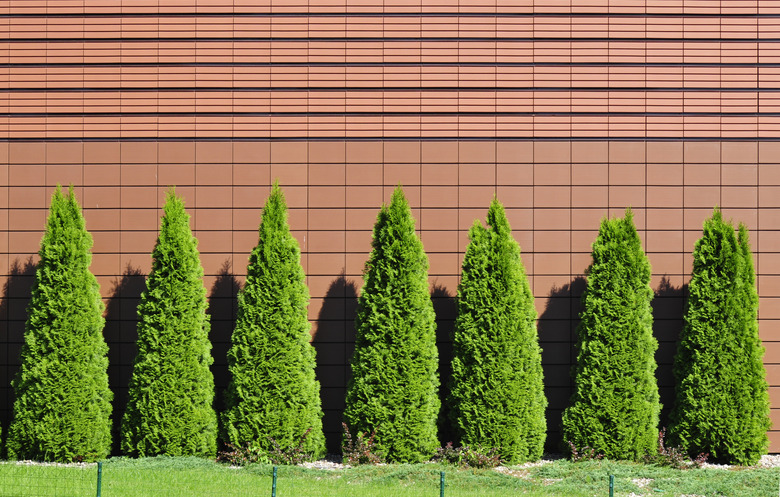Why Do My Arborvitae Turn Brown?
Some browning during winter is normal for American arborvitae (Thuja occidentalis, USDA zones 2-7), but arborvitae browning at other times of year could be a sign of drought stress or disease. Also called Eastern arborvitae or white cedar, American arborvitae are tall, evergreen trees. They thrive on moist, well-draining soil and in full sun or partial shade.
Winter Arborvitae Browning
Winter Arborvitae Browning
Arborvitae foliage may turn brown naturally in winter in the coldest regions of this tree's hardiness range, and inner branches may drop. The outer foliage on arborvitae turns yellow-green or brown-green when temperatures drop in winter across the coldest regions of its hardiness range. At the same time, small inner branches may turn brown and fall, which can make the trees look browner than normal. In spring, new green foliage grows, improving the trees' overall color.
Arborvitae Browning from Dry Roots
Arborvitae Browning from Dry Roots
Dry roots can cause arborvitae problems. These trees don't tolerate drought, and newly transplanted trees are especially at risk if their root balls aren't soaked after transplantation and they're not kept well-watered until the roots become established.
If you suspect a tree is suffering from dry roots, dig down carefully 6 to 9 inches between the roots closest to the trunk and feel the soil. Soil that's moist to the touch doesn't require watering, but if the soil feels dry, place a garden hose near the trunk on the soil's surface and leave it to drip steadily for an hour or two. In dry weather, apply 10 gallons of water for each 1 inch of trunk diameter at knee height three times per month, watering evenly within the drip line of the tree. An average garden hose supplies 10 gallons of water every five minutes.
Arborvitae Browning from Twig Blights
Arborvitae Browning from Twig Blights
Brown or ash-gray twiggy material that remains on arborvitae for months is a symptom of twig blight. Phomopsis twig blight (Phomopsis juniperovora), kabatina twig blight (Kabatina thujae) and pestalotiopsis tip blight (Pestalotiopsis funerea) are fungal diseases that infect arborvitae.
Kabatina affects 1-year-old American arborvitae, and phomopsis twig blight and pestalotiopsis tip blight affect trees of any age. A common sign of twig blight infection is the appearance of small, black spots appearing where living wood meets dead tissue. Sterilize pruning shears by wiping the blades with a cloth soaked in rubbing alcohol before making each cut, and prune arborvitae suffering from twig blight. Prune branches and twigs 3 inches below the beginning of the dead tissue, and put all the trimmings in the trash.
Arborvitae Problems from Insects
Arborvitae Problems from Insects
Signs of leafminer infestations in arborvitae include yellow or brown leaf tips that appear in late winter and early spring. In early and midsummer, leafminer moths lay eggs between arborvitae leaf scales, and after the larvae hatch, they burrow inside the foliage to feed. By the following spring, the leaves and twigs are hollowed out and break off easily.
Prune infested tips with sterilized pruning shears to control light infestations or treat heavily infested trees with a systemic pesticide such as one that contains carbaryl or imidacloprid. Put on a long-sleeved shirt, long pants, gloves and safety goggles, and follow all label directions and precautions.
References
- Missouri Botanical Garden: Thuja Occidentalis
- Colorado State University Extension: Caring for Trees in a Dry Climate
- Penn State Extension: Arborvitae Diseases
- Virginia Cooperative Extension: Eastern Arborvitae, American Arborvitae, White Cedar
- Missouri Botanical Garden: Thuja Occidentalis "Nigra"
- University of Illinois Extension: Arborvitae Turning Brown
- Missouri Botanical Garden: Thuja Occidentalis "Techny"
- Missouri Botanical Garden: Thuja Occidentalis "Rheingold"
- Cornell Cooperative Extension Nassau County: Arborvitae Problems
- University of Minnesota: Arborvitae Leafminer
